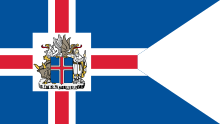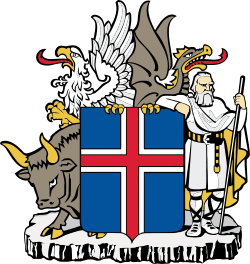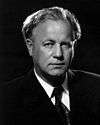President of Iceland
The President of Iceland (Icelandic: Forseti Íslands) is the head of state of Iceland. The incumbent is Guðni Thorlacius Jóhannesson, who is now in his first term as president, elected in 2016.
| President of Iceland
Forseti Íslands | |
|---|---|
 Presidential coat of arms | |
 | |
.jpg) Guðni Thorlacius Jóhannesson since 1 August 2016 | |
| Office of the President | |
| Member of | State Council of Iceland |
| Residence | Bessastaðir |
| Seat | Garðabær, Capital Region |
| Term length | Four years Renewable indefinitely as long as the incumbent wins presidential elections or is uncontested. |
| Constituting instrument | Constitution of Iceland |
| Precursor | King of Iceland |
| Inaugural holder | Sveinn Björnsson |
| Formation | 17 June 1944 |
| Succession | Collective President of the Parliament, Prime Minister and President of the Supreme Court. |
| Salary | €289,000 annual[1] (2017) |
| Website | english forseti |
 |
|---|
| This article is part of a series on the politics and government of Iceland |
| Constitution |
|
Institutions Executive
Legislative
Judicial
|
|
Elections
|
|
Administrative divisions
|
|
Foreign relations
|
|
The president is elected to a four-year term by popular vote, is not term-limited, and has limited powers. The presidential residence is situated in Bessastaðir in Garðabær, near the capital city Reykjavík.
Origin
When Iceland became a Republic in 1944 by the passing of a new Constitution the position of King of Iceland was simply replaced by the president of Iceland. A transitional provision of the new constitution stipulated that the first president be elected by the parliament.
Powers and duties
Executive powers
Cabinet
The president appoints ministers to the Cabinet of Iceland, determines their number and division of assignments. Ministers are not able to resign and must be discharged by the president. The ministers are delegated the president's executive powers and are solely responsible for their actions.
In the aftermath of general elections, the president has the role to designate a party leader (the one that the president considers most likely to be able to form a majority coalition government) to formally start negotiations to form a government.[2] Sveinn Björnsson and Ásgeir Ásgeirsson played highly active roles in the formation of governments, attempting to set up governments that suited their political preferences, whereas Kristján Eldjárn and Vigdís Finnbogadóttir were passive and neutral as to individuals and parties comprising the government.[3]
State Council
The president and the Cabinet meet in the State Council. The Cabinet must inform the president of important matters of the state and drafted bills. During meetings the Cabinet may also suggest convening, adjourning or dissolving the Parliament.
Prosecution and pardoning
The president can decide that the prosecution for an offense be discontinued and can also grant pardon and amnesty.
Legislative powers
Article 2 of the constitution states that the president and the Parliament jointly exercise the legislative power. The president signs bills passed by the Parliament into law and can choose not to sign them, thus in effect vetoing them. Bills vetoed by the president do take effect immediately, should the Parliament not withdraw them, but they must be confirmed in a referendum. Ólafur Ragnar Grímsson (1996–2016) is the only president to have vetoed legislation from the Parliament, having done so on three occasions (2004, 2010, 2011). This power was originally intended to be used only in extremely extenuating circumstances.[4]
The president has the power to submit bills and resolutions to the Parliament which it must take under consideration. Should the Parliament not be in session the president can issue provisional laws which must conform with the constitution. Provisional laws become void if the Parliament does not confirm them when it convenes. No president has ever submitted bills nor resolutions, nor issued provisional laws.
Article 30 of the constitution states that the president can grant exceptions from laws. No president has ever exercised this authority.
Parliament
The president convenes the Parliament after general elections and dissolves it. He can temporarily adjourn its sessions and move them if he deems so necessary. Furthermore, the president opens all regular sessions of the Parliament each year.
Ceremonial duties
The president is the designated grand master of the Order of the Falcon.
Compensation
The president receives a monthly salary of 2,480,341 ISK. Article 9 of the constitution states the salary cannot be lowered for an incumbent president.
Residence
Article 12 of the constitution states that the president shall reside in or near Reykjavík. Since inception the official residence of the president has been Bessastaðir which is in Garðabær.
Eligibility
Articles 4 and 5 of the constitution set the following qualifications for holding the presidency:
- meet the qualifications specified for parliamentarians
- be at least thirty-five years old
- have at least 1,500 commendations
Succession
Articles 7 and 8 of the constitution state that when the president dies or is otherwise unable to perform his duties, such as when he is abroad or sick, the prime minister, the president of the parliament and the president of the Supreme Court shall collectively assume the power of the office. Their meetings are led by the president of the parliament where they vote on any presidential decisions. The presidential term is completed and a new president is elected by the general public.
Removal
Article 11 of the constitution lays out the process by which the president can be removed from office. It states that the president does not bear responsibility for the actions of his government and that he can not be prosecuted without consent of the Parliament. A referendum instigated by the Parliament with 3/4 support must approve of his removal. Once the Parliament has approved of the referendum, the president must temporarily step aside until the results of the referendum are known. The referendum must be held within two months of the vote, and, should the removal be rejected by the people, then the Parliament must immediately be dissolved and a new general election held.
A removal from office has not occurred since the founding of the republic.
List
There have been six presidents since the establishment of the republic.
Term: 1 appointed · 2 died in office · 3 uncontested
| Nº | President | Took office | Left office | Duration | Term | Prime ministers | |
|---|---|---|---|---|---|---|---|
| 1 |  |
Sveinn Björnsson (1881–1952) |
17 June 1944 | 25 January 19522 | 7 years, 7 months, 8 days (2,778 days) |
1 (1944)1 | Björn Þórðarson Ólafur Thors Stefán Jóhann Stefánsson Ólafur Thors Steingrímur Steinþórsson |
| 2 (1945)3 | |||||||
| 3 (1949)3 | |||||||
| Regent of Iceland 1941–1944, later became the first president of Iceland. In 1950 considered forming a government that did not rely on parliamentary support after leaders of the parliamentary parties had reached an impasse. The only president to die in office; this led to a vacancy, the powers of the office being constitutionally vested jointly in the prime minister (Steingrímur Steinþórsson), the president of the Parliament (Jón Pálmason) and the president of the Supreme Court (Jón Ásbjörnsson). | |||||||
| 2 |  |
Ásgeir Ásgeirsson (1894–1972) |
1 August 1952 | 1 August 1968 | 16 years (5,844 days) |
4 (1952) | Steingrímur Steinþórsson Ólafur Thors Hermann Jónasson Emil Jónsson Ólafur Thors Bjarni Benediktsson Ólafur Thors Bjarni Benediktsson |
| 5 (1956)3 | |||||||
| 6 (1960)3 | |||||||
| 7 (1964)3 | |||||||
| First president elected by popular vote. | |||||||
| 3 | .jpg) |
Kristján Eldjárn (1916–1982) |
1 August 1968 | 1 August 1980 | 12 years (4,383 days) |
8 (1968) | Bjarni Benediktsson Jóhann Hafstein Ólafur Jóhannesson Geir Hallgrímsson Ólafur Jóhannesson Benedikt Sigurðsson Gröndal Gunnar Thoroddsen |
| 9 (1972)3 | |||||||
| 10 (1976)3 | |||||||
| At one point considered forming a government that did not rely on parliamentary support after leaders of the parliamentary parties had reached an impasse. | |||||||
| 4 | .jpg) |
Vigdís Finnbogadóttir (born 1930) |
1 August 1980 | 1 August 1996 | 16 years (5,844 days) |
11 (1980) | Gunnar Thoroddsen Steingrímur Hermannsson Þorsteinn Pálsson Steingrímur Hermannsson Davíð Oddsson |
| 12 (1984)3 | |||||||
| 13 (1988) | |||||||
| 14 (1992)3 | |||||||
| Was the world's first elected female president and overwhelmingly won a contested election in 1988. | |||||||
| 5 | .jpeg) |
Ólafur Ragnar Grímsson (born 1943) |
1 August 1996 | 1 August 2016 | 20 years (7,305 days) |
15 (1996) | Davíð Oddsson Halldór Ásgrímsson Geir Haarde Jóhanna Sigurðardóttir Sigmundur Davíð Gunnlaugsson Sigurður Ingi Jóhannsson |
| 16 (2000)3 | |||||||
| 17 (2004) | |||||||
| 18 (2008)3 | |||||||
| 19 (2012) | |||||||
| First to use the constitutional authorisation to deny signing a law from the parliament, thus sending the law to a national referendum, on three occasions. | |||||||
| 6 |
|
Guðni Thorlacius Jóhannesson (born 1968) |
1 August 2016 | Incumbent | 3 years, 268 days (1363 days) |
20 (2016) | Sigurður Ingi Jóhannsson Bjarni Benediktsson Katrín Jakobsdóttir |
See also
- First Lady of Iceland
- Icelandic presidential elections
- List of rulers of Iceland
- List of personal coats of arms of Presidents of Iceland
References
- "Iceland's president turns down a monthly pay increase of 5,300 USD".
- "Hvað gerir forseti Íslands og hvaða völd hefur hann?". Vísindavefurinn. Retrieved 2016-12-31.
- Jóhannesson, Guðni Th. (2016). Fyrstu forsetarnir. p. 196.
- Jóhannesson, Guðni Th. (2016). Fyrstu forsetarnir. p. 57.
